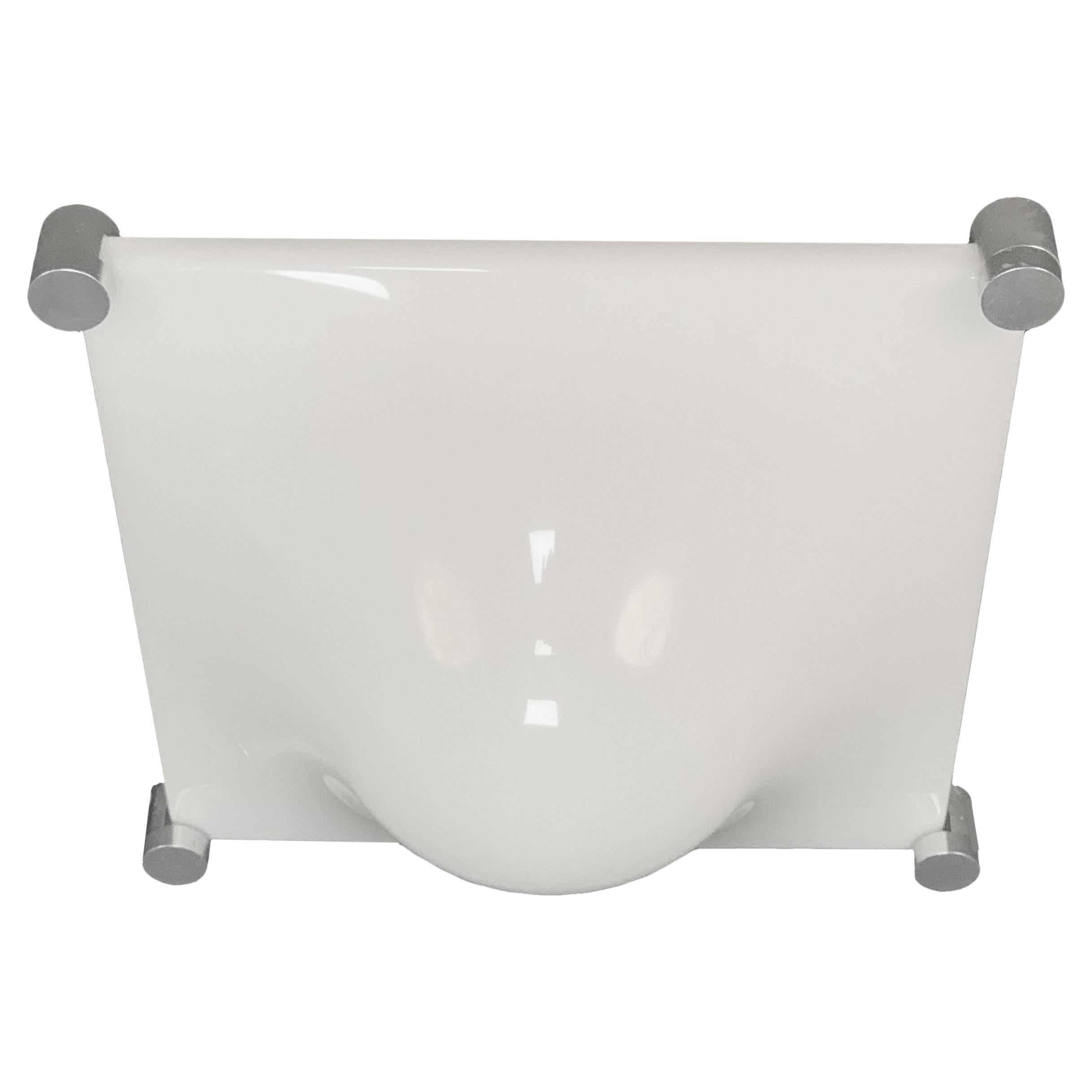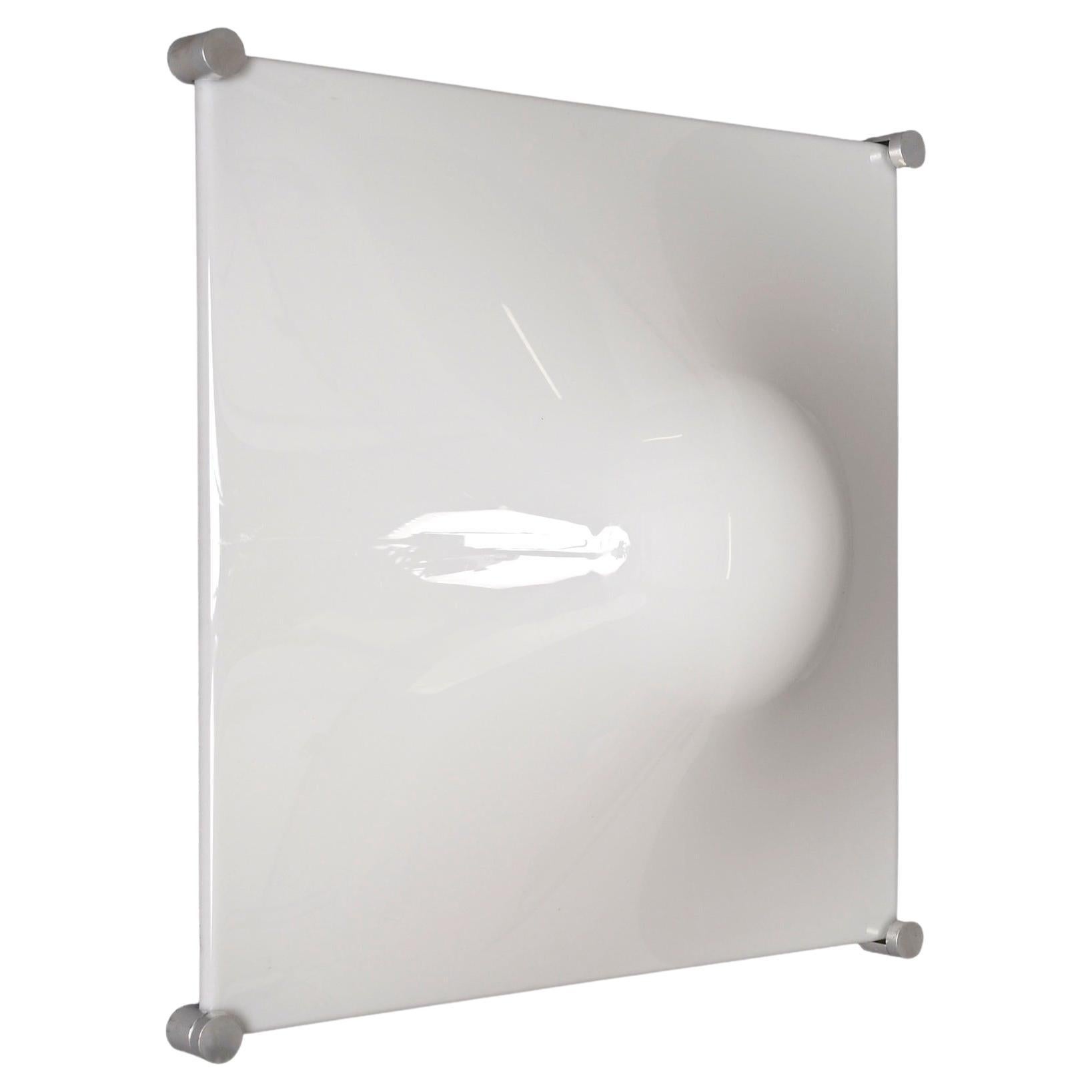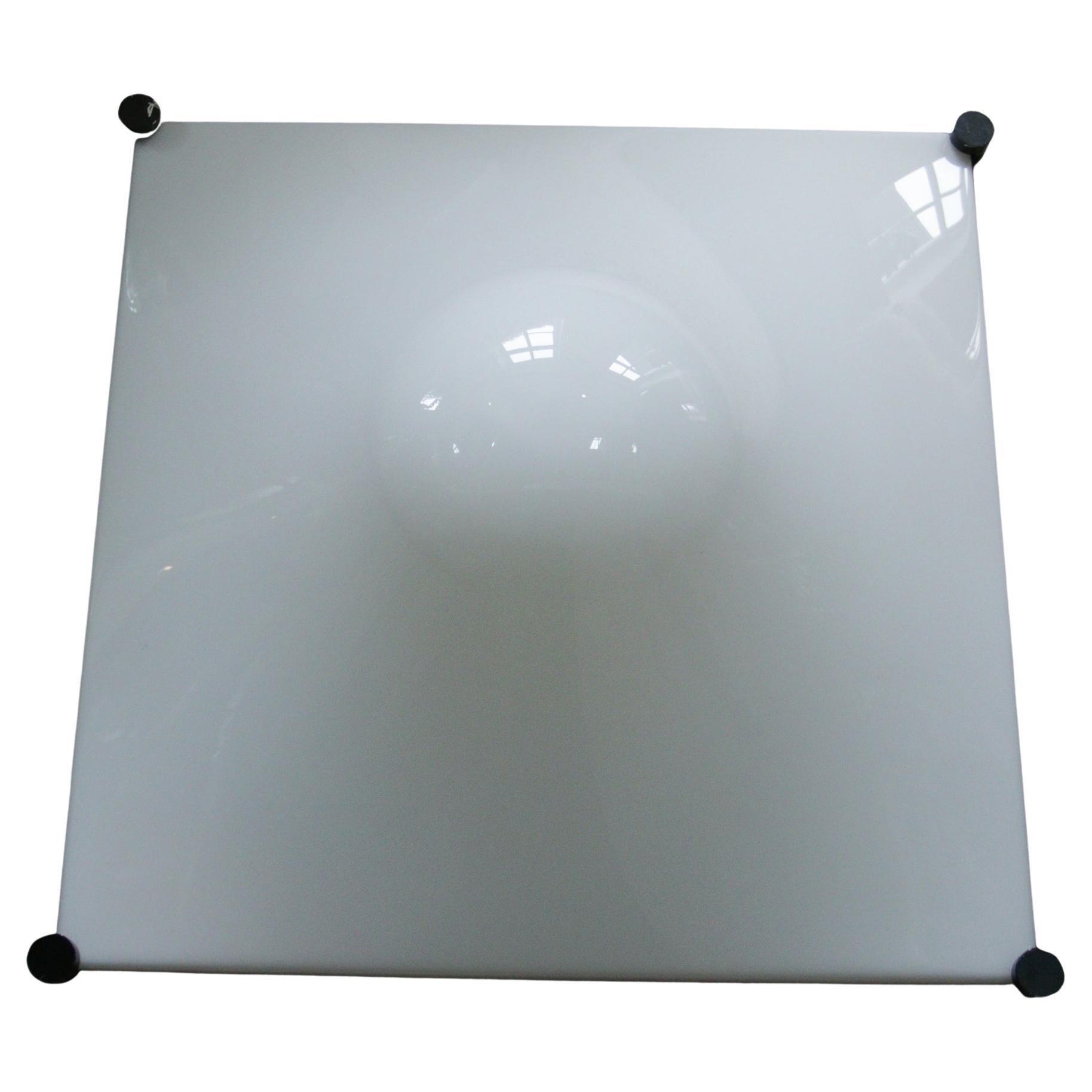Items Similar to Pair of Martinelli Luce Midcentury White Plexiglass Italian "Bolla Light", 1960s
Want more images or videos?
Request additional images or videos from the seller
1 of 14
Pair of Martinelli Luce Midcentury White Plexiglass Italian "Bolla Light", 1960s
About the Item
Wonderful midcentury pair of "Bolla Lamp" in white perspex. Elio Martinelli designed these items were produced in Italy during the 1960s.
These white plexiglass lamps are unique as they can be mounted onto the ceiling or wall. In addition, there are rotating aluminium spacers in the four corners.
An elegant and versatile pair of sconces that will smarten a modern living room or bedroom.
Italian lighting designer Elio Martinelli was born in 1921 in Lucca in Tuscany. He attended a vocational school before going on to study set design at the Academy of Fine Arts in Florence, where he ultimately earned a diploma. After school, he began working in his father’s lighting business, while also taking on his own interior design projects for restaurants, hotels, and shops, with an aesthetic inspired by his set design background. During this period, initially out of necessity, he also began designing and producing his own lighting. In 1950, Martinelli formally established his own lighting company, Martinelli Luce, in Lucca; the company has since gone on to produce numerous lighting designs for domestic and commercial use.
Throughout his career, Martinelli embraced new materials (such as methacrylate), and his work was representative of the midcentury modernist Italian aesthetic, characterized by an organic geometry both rationalistic and expressive. Standout pieces include, among others, the space-age table lamps Serpente (1965), Cobra (1968), and Foglia (1969). Following an invitation from designer Gio Ponti, Martinelli’s company participated in the first edition of the international design exhibition, Eurodomus, held in Turin in 1966. It went on to attend the 1968, 1970, and 1972 editions as well.
Martinelli continued to work until his passing in 2004. The company continues to operate today with Martinelli’s family at the helm. The Montreal Decorative Arts Museum, the Metropolitan Museum of Art in New York, and the Museum of Art in Philadelphia each hold multiple Martinelli Luce models in their permanent collections.
- Creator:Elio Martinelli (Designer),Martinelli Luce (Manufacturer)
- Dimensions:Height: 7.09 in (18 cm)Width: 14.57 in (37 cm)Depth: 14.57 in (37 cm)
- Sold As:Set of 2
- Style:Mid-Century Modern (Of the Period)
- Materials and Techniques:
- Place of Origin:
- Period:
- Date of Manufacture:1960s
- Condition:
- Seller Location:Roma, IT
- Reference Number:1stDibs: LU3067331310112
About the Seller
5.0
Platinum Seller
These expertly vetted sellers are 1stDibs' most experienced sellers and are rated highest by our customers.
Established in 1990
1stDibs seller since 2017
1,223 sales on 1stDibs
Typical response time: 1 hour
- ShippingRetrieving quote...Ships From: Roma, Italy
- Return PolicyA return for this item may be initiated within 14 days of delivery.
More From This SellerView All
- Martinelli Midcentury White Plexiglass Italian "Bolla Light" 1960sBy Elio Martinelli, Martinelli LuceLocated in Roma, ITWonderful midcentury white plexiglass "Bubble Lamp" wall or ceiling Light. This item was produced in Italy during the 1960s. This sconce was designed by Elio Martinelli, this white plexiglass lamp...Category
Late 20th Century Italian Mid-Century Modern Flush Mount
MaterialsAluminum
- Midcentury Martinelli Luce "Bolla Light" White Acrylic Italian Sconce, 1960sBy Martinelli Luce, Elio MartinelliLocated in Roma, ITWonderful micentury wall lamp or sconce in white plexiglass "Bolla Lamp". Elio Martinelli designed this item in Italy during the 1960s for Martinelli Luce. ...Category
Late 20th Century Italian Mid-Century Modern Flush Mount
MaterialsAluminum
- Castiglioni Midcentury Metal "Light Ball" Italian Sconce for Flos, 1960sBy Achille & Pier Giacomo Castiglioni, FlosLocated in Roma, ITIncredible mid-century "Light Ball large size" applique in smatised ivory metal and opal glass for Flos. This fantastic lamp was designed by Achille Castiglioni and produced in Italy for Flos in the 1960s. This fantastic light is unique because of the materials, made of ivory white enameled metal and opal glass. Requires an E27 bulb. A fantastic piece that will grace a mid-century living room or bathroom. Measures (cms): diameter - 42 height - 31 Literature: Casa Amica, 27 June 1972, p. 105 Octagon 30 September 1973, p. 149 Sergio Polano, Achille Castiglioni all the works, Electa, Milano, 2001, p. 224 Giuliana Gramigna, repertoire 1950-2000, Allemandi, Torino, 2003, p. 121. The beginnings of Flos (meaning “flower” in Latin) blossomed from a brilliant idea: to create objects, starting with a light bulb, that would change the way of life for both the Italian market and the foreign markets. Dino Gavina and the small Eisenkeil manufacturing facility in Merano, had already been creating furniture alongside design masters such as Achille and Pier Giacomo Castiglioni, Afra and Tobia Scarpa. But by the early 1960s, Gavina became convinced the time had come to create new lamps. Using the same technology – conceived in the USA and tested at Eisenkeil – used for the Cocoon lampthe Castiglioni brothers and the Scarpa duo began creating lamps such as the Taraxacum or the Fantasma, with many other beautiful and surprising lamps to follow. And so, from day one, Flos was already reinventing the idea of artificial lighting. Achille Castiglioni (born February 16, 1918, Milan–died December 2, 2002, Milan) was a prolific furniture, lighting, and product Italian designer renown for his ironic, joyful, creative and functional designs that, at times, intersected with ideas explored by conceptual artists. Achille Castiglioni was born into a family with deep appreciation for the arts, as he was the third son of sculptor and coin engraver Giannino Castiglioni and his wife Livia Bolla. He first studied the classics at the Liceo Classico Giuseppe Parini, but then switched to study art at the Accademia di Belle Arti di Brera in Milan. In 1937, he decided to follow the steps of his two elder brothers, architects Livio and Pier Giacomo Castiglioni, by enrolling in the Faculty of Architecture at the Politecnico di Milano, graduating in 1944–after having to interrupt his studies when he was stationed in Greece and Sicily during World War II. In 1944, immediately after graduating, Achille Castiglioni joined his brothers Livio and Pier Giacomo in the design studio that they had founded with Livio’s classmate Luigi Caccia Dominioni in 1937 in Milan. Fortunately for Achille, from the very beginning Livio and Pier Giacomo decided to focus almost entirely on designing exhibitions, furniture, housewares, and appliances since architectural commissions were difficult to come by during the war. This product-design focus, and the deep fraternal bound among the three brothers, would later allow the young Achille to experiment early in his career with emerging techniques and new materials that could communicate a fresh aesthetic sensibility suited for the positive outlook of the post-war European market. The Castiglioni brothers’ important collaboration with Phonola and Brionvega In 1940, Pier Giacomo Castiglioni, Livio Castiglioni, and Luigi Caccia Dominioni, in collaboration withe the Phonola company, presented in the VII Triennale di Milano (Milan Triennial), titled Exhibition of the Radio, a research study of radio devices that included the Fimi Phonola 547 radio, the first radio encased in Bakelite instead of wood. Shortly after the exhibition, Luigi Caccia Dominioni suspended his professional activity to serve in the military during World War II and left the studio. The development of the FImi Phonola 547 radio would prove fruitful for the three brothers, as it allowed Livio Castiglioni to cement his role as the leading design consultant for Phonola from 1940 until 1960, and for Brionvega, from 1960 until 1964. These relationships brought in further collaboration among the three brothers, and would eventually result in several designs for radio and sound appliances with innovative materials and shapes for which Achille Castiglioni played a key role, such as the RR 226 stereo system for Brinovega (1965), the radio phonograph...Category
Vintage 1960s Italian Mid-Century Modern Flush Mount
MaterialsMetal
- Castiglioni Midcentury Chromed Metal "Light Ball" Italian Sconce for Flos, 1960sBy Achille & Pier Giacomo Castiglioni, FlosLocated in Roma, ITAmazing midcentury "Light Ball' sconce chrome metal and opaline glass for Flos. This fantastic item was designed by Achille Castiglioni and manufactured in Italy for Flos during the 1960s. This amazing piece is unique because of the materials, as it is made of chromed metal and opaline glass. Each light takes one E27 75w maximum bulb. A great sconce that will smarten a midcentury living room or bathroom. Literature: Casa Amica, 27 June 1972, p. 105 Octagon 30 September 1973, p. 149 Sergio Polano, Achille Castiglioni all the works, Electa, Milano, 2001, p. 224 Giuliana Gramigna, repertoire 1950-2000, Allemandi, Torino, 2003, p. 121. The beginnings of Flos (meaning “flower” in Latin) blossomed from a brilliant IDEA: to create objects, starting with a light bulb, that would change the way of life for both the Italian market and the foreign markets. Dino Gavina and the small Eisenkeil manufacturing facility in Merano, had already been creating furniture alongside design masters such as Achille and Pier Giacomo Castiglioni, Afra and Tobia Scarpa. But by the early ‘60s, Gavina became convinced the time had come to create new lamps. Using the same technology – conceived in the USA and tested at Eisenkeil – used for the Cocoon lampthe Castiglioni brothers and the Scarpa duo began creating lamps such as the Taraxacum or the Fantasma, with many other beautiful and surprising lamps to follow. And so, from day one, Flos was already reinventing the IDEA of artificial lighting. Achille Castiglioni (born February 16, 1918, Milan–died December 2, 2002, Milan) was a prolific furniture, lighting, and product Italian designer renown for his ironic, joyful, creative and functional designs that, at times, intersected with ideas explored by conceptual artists. Achille Castiglioni was born into a family with deep appreciation for the arts, as he was the third son of sculptor and coin engraver Giannino Castiglioni and his wife Livia Bolla. He first studied the classics at the Liceo Classico Giuseppe Parini, but then switched to study art at the Accademia di Belle Arti di Brera in Milan. In 1937, he decided to follow the steps of his two elder brothers, architects Livio and Pier Giacomo Castiglioni, by enrolling in the Faculty of Architecture at the Politecnico di Milano, graduating in 1944–after having to interrupt his studies when he was stationed in Greece and Sicily during World War II. In 1944, immediately after graduating, Achille Castiglioni joined his brothers Livio and Pier Giacomo in the design studio that they had founded with Livio’s classmate Luigi Caccia Dominioni in 1937 in Milan. Fortunately for Achille, from the very beginning Livio and Pier Giacomo decided to focus almost entirely on designing exhibitions, furniture, housewares, and appliances since architectural commissions were difficult to come by during the war. This product-design focus, and the deep fraternal bound among the three brothers, would later allow the young Achille to experiment early in his career with emerging techniques and new materials that could communicate a fresh aesthetic sensibility suited for the positive outlook of the post-war European market. The Castiglioni brothers’ important collaboration with Phonola and Brionvega In 1940, Pier Giacomo Castiglioni, Livio Castiglioni, and Luigi Caccia Dominioni, in collaboration withe the Phonola company, presented in the VII Triennale di Milano (Milan Triennial), titled Exhibition of the Radio, a research study of radio devices that included the Fimi Phonola 547 radio, the first radio encased in Bakelite instead of wood. Shortly after the exhibition, Luigi Caccia Dominioni suspended his professional activity to serve in the military during World War II and left the studio. The development of the FImi Phonola 547 radio would prove fruitful for the three brothers, as it allowed Livio Castiglioni to cement his role as the leading design consultant for Phonola from 1940 until 1960, and for Brionvega, from 1960 until 1964. These relationships brought in further collaboration among the three brothers, and would eventually result in several designs for radio and sound appliances with innovative materials and shapes for which Achille Castiglioni played a key role, such as the RR 226 stereo system for Brinovega (1965), the radio phonograph RR 126 for Brinovega (1965), and the radio and record player RR 128 for Brionvega (1966) In 1952, Livio decided to build his own practice, independent from Achille and Pier Giacomo, to pursue a deeper exploration of radio waves, music, and technology. But the three brothers would continued to collaborate closely in several projects, and the partnership between Achille and Pier Giacomo became so tight that from 1952 until 1968, when Pier Giacomo died, they co-authored most of their designs. Achille Castiglioni Long Career as Light Designer During this period, the Castiglioni brothers participated in the Italian Exhibition of Furniture (RIMA), where they successfully introduced a series of curved-plywood furniture, and presented important designs, such as the Tubino lamp (1949), originally produced by Italian light maker Arteluce from 1949 until 1974, and reintroduced by Flos since the late 1970s; and the Luminator lamp (1955), originally produced by Gilardi & Barzaghi, but reintroduced by Flos in the late 1960s. A new, successful, and long-lasting collaboration developed in 1960, when Pier Giacomo and Achille Castiglioni were reached by entrepreneurial Italian designer Dino Gavina and business man Arturo Eisenkeil with the IDEA to create a completely new kind of lighting fixtures utilizing a polyamide. The Material, which they called “cocoon,” in the hands of the Castiglioni brothers would become a popular and iconic innovation in the 1960s and serve as the successful foundation of Italian lighting company Flos–founded by Gavina and Eisenkeil in 1962. Pier Giacomo and Achille Castiglioni designed a series of “cocoon” lights utilizing the spray-on polyamide plastic as a coating layer onto a metal frame. Among the most popular Castiglioni “cocoon” lights are: the Taraxacum and the Viscontea ceiling lamps (1960), and the Gatto table lamp (1961). Other of the important lamp designs by Pier Giacomo and Achille Castiglioni for Flos are the Beehive -or Splügen Braü lamp (1961), Toio –or Toy lamp...Category
Vintage 1960s Italian Mid-Century Modern Flush Mount
MaterialsChrome, Metal
- White "Light Ball" by Flos, Italian Wall or Ceiling Lamp, Castiglioni 1960sBy Achille Castiglioni, FlosLocated in Roma, ITGorgeous white Light Ball, designed by Achille Castiglioni for Flos in Italy in the 1960s. in white metal and opal glass. This fantastic lamp was designed by Castiglioni for Arteluc...Category
Vintage 1960s Italian Mid-Century Modern Flush Mount
MaterialsMetal
- Italian White Opaline Glass Sconce by Zonca, Italy, 1960sBy ZoncaLocated in Roma, ITGorgeous white Murano glass wall lamp, signed by Zonca, this astonishing piece was designed in Italy in the 1960s. This large sconce features two incredible white opaline Murano ...Category
Mid-20th Century Italian Mid-Century Modern Wall Lights and Sconces
MaterialsMetal
You May Also Like
- Bolla 60 Ceiling / Wall Lamp by Martinelli Luce, 1960sBy Martinelli Luce, Elio MartinelliLocated in Boven Leeuwen, NLIconic Bolla 60 ceiling lamp by Elio Martinelli for Martinelli Luce, 1960s. Ceiling or wall light in methacrylate opaque white shade and aluminium corners....Category
Vintage 1960s Italian Mid-Century Modern Wall Lights and Sconces
MaterialsAluminum
- Pair of Midcentury Sconces Bolla 50 for Luce, Italy, 1960By Elio MartinelliLocated in Saarbruecken, DEElio Martinelli wall light Bolla designedfor Martinelli Luce, Italy, 1960. Usable as sconce or ceiling light. Large version! Very good vintage condition! Signed inside! Ceil...Category
Vintage 1960s Italian Mid-Century Modern Wall Lights and Sconces
MaterialsAluminum
- Italian Model Bolla Sconce by Elio Martinelli for Martinelli Luce, 1960sBy Martinelli Luce, Elio MartinelliLocated in HEVERLEE, BESpace age Bolla wall lamps by Elio martinelli for Martinelli Luce. Lovely timeless space age design. They can be used as ceiling or as wall lamps 1980s - Belgium Dimensions: Heig...Category
Vintage 1960s Italian Space Age Wall Lights and Sconces
MaterialsPlastic
- Bolla Flush Mount or Wall Lamp by E. Martinelli for Martinelli Luce, 1960sBy Elio Martinelli, Martinelli LuceLocated in Antwerp, BEMid-Century Modern Bolla light by E. Martinelli.This timeless design Classic wall lamp was designed by Elio Martinelli for Martinelli Luce in 1960.Th...Category
Vintage 1960s Italian Mid-Century Modern Flush Mount
MaterialsAluminum
- Italian mid-century modern white wall lamp Bolla Martinelli Martinelli Luce 1965By Martinelli Luce, Elio MartinelliLocated in MIlano, ITItalian mid-century modern white wall lamp Bolla Martinelli Martinelli Luce, 1965 Square wall light mod. Bolla. Largest model of the three available s...Category
Vintage 1960s Italian Mid-Century Modern Wall Lights and Sconces
MaterialsMetal
- Large Bolla Wall or Ceiling Light Elio Martinelli (Designer), 1960s, ItalyBy Elio Martinelli, Martinelli LuceLocated in Den Haag, NLExtra Large Bolla wall or ceiling lamp. Design by Elio Martinelli produced by his company Martinelli Luce in the 1960s Italy .4 Large E27 bulbs needed. Plastic shade on a Metal b...Category
Vintage 1960s Italian Space Age Wall Lights and Sconces
MaterialsPlastic
Recently Viewed
View AllMore Ways To Browse
Design Vintage Background
Design Background Vintage
Italian Modern Light White
Italian Lighting Designers
Aluminum Space
Mounted Table Art
Plexiglass Italian
Plexiglass Italy
Vintage Italy Aesthetic
Restaurant Lighting
Vintage Bedroom Lighting
Plexiglas Lamp
Plexiglass Lamp
Plexi Lamp
Wall Mounted Dining Table
Wall Mounted Entry Table
Wall Mount Entry Table
Academy Lighting





